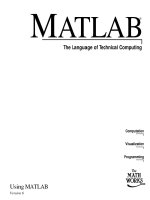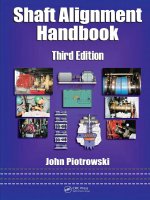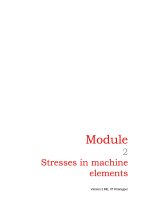Inspection of Vertical Transportation Equipment_12 doc
Bạn đang xem bản rút gọn của tài liệu. Xem và tải ngay bản đầy đủ của tài liệu tại đây (868.72 KB, 27 trang )
16-29
Simpo PDF Merge and Split Unregistered Version -
CHAPTER 17
BOX CONVEYORS
17.1 INTRODUCTION
NOTE: Paragraphs identified with a vertical. line in the left margin are inspections that
should be made by Certified Vertical Transportation Equipment Inspectors only.
17.1.1 Scope
The inspection of box conveyors included in this chapter is not only an inspection of all safety
related functions, but puts heavy emphasis on an inspection to determine the condition of the
equipment and identify areas that need improvement. Proper maintenance is needed to keep the
conveying systems operating in an efficient manner. When preventive maintenance is lacking,
shutdowns will occur. The design and application of these devices give the user only limited
access to the operating equipment. Therefore, user safety considerations are quite limited. This
chapter will identify these safety items, as well as performance considerations. See Figures 17-1
and 17-2, which show various box conveyor arrangements with component names that will be
used in this chapter.
17.1.2 Use
Box Conveyors are generally used to transport small loads (20 pounds or less) from place to
place in either a vertical or horizontal direction. The systems can be as simple as two stations or
as complex as several hundred interconnected stations. The devices are found in a number of
hospitals and in some office buildings. They carry a variety of items such as supplies, mail,
records, drugs, etc. There are two basic types of box conveyors that will be discussed in this
chapter. Because of the major difference between the two, we will address the inspection of each
separately.
17.1.3 Applicable Safety Standards
There is no safety standard written specifically for this type of equipment. Section 5,
GENERAL SAFETY STANDARDS ANSI/ASME B20.1 Safety Standards for Conveyors and
Related Equipment, could be used as guidance for the mechanical aspects, while NFPA 101-Life
Safety Code is used for building penetration requirements. These devices can penetrate
horizontally as well as vertically.
17-1
Simpo PDF Merge and Split Unregistered Version -
17-2
Simpo PDF Merge and Split Unregistered Version -
17-3
Simpo PDF Merge and Split Unregistered Version -
17.1.4 Inspection Interval
The inspection interval should be determined by the application of the equipment and the
environment in which it works. Inspections of self propelled box conveyors may be needed more
often because of the complexity of the system, while the selective vertical conveyor is more
rugged and less complex in design. Neither type unit should be inspected at less than 6 month
intervals.
17.2 INSPECTION OF SELF-PROPELLED BOX CONVEYOR
17.2.1 General Description
The self propelled box conveyor system is made up of an assortment of various parts that are
assembled to suit a specific application. The system could be as simple as the type shown in
Figure 17-3 or more complex as that shown in Figure 17-1. The carriers are independently
powered modules that move from a point to a selected destination by way of a track system. It is
capable of moving in both a horizontal and vertical direction. The module is powered by a series
of bus rails that are located in the track. The system is operated by establishing a destination on
the module and giving it a start signal. The module will proceed into the track system. At
various discussion points along the way, the destination is automatically read and the track path
is adjusted accordingly until the module arrives at its destination. There are several
manufacturers of this type of equipment. The basic concept is the same. However each
manufacturer has a different approach to accomplishing the result. We will try to show the
various designs as we proceed. Because there is no one standard system design, we will address
our inspection to the various components. The inspector will have to tailor his/her inspection
procedure to suite the specific system he/she is inspecting.
17.2.2 Track
17.2.2.1 Design. The system uses modular, extruded aluminum track sections. Two of the
track power rails provide 24 volt D.C. power to the module motors, while the third rail feeds
control logic commands. Horizontal car movement relies on friction drive, while vertical
movement engages gearing between the track and the module. Figure 17-4 show three basic
track designs used today.
17-4
Simpo PDF Merge and Split Unregistered Version -
17-5
Simpo PDF Merge and Split Unregistered Version -
17-6
Simpo PDF Merge and Split Unregistered Version -
17.2.2.2 Maintenance. Clean track is essential if the system is to be kept operating. The
inspector should examine the track to see that housekeeping is being done. He/she should also
check the condition of the power and logic rails to see that they are clean and free of oxidation.
The track environment should control the frequency and intensity of this examination. Areas
subject to dust and dirt should be checked more often than a sterile area. Electrical and
mechanical connections should be checked, especially in areas subject to vibration, such as track
going into and away from switch track. The gear rack on vertical track should be closely
examined. This rack calories the weight of the modules as they move vertically and are subject
to wear. It is not necessary to replace the track section if the rack is wearing. The racks are
modularly constructed for replacement purposes. Tracks in public areas should be closely
examined for sharp edges. They should also be checked for damage. Any piece of equipment
that is exposed to people is subject to damage.
17.2.3 Switches
Because of the mechanical movement, switches sustain the most wear of any part in the
system. The inspector should closely examine them for wear and ascertain that proper types and
amounts of lubrication are being used. Any wear should be noted so that repairs can be made
prior to system shutdowns. Associated with the switches are the destination readers. Since
switches are decision points, readers are located near the switches to determine the path of the
module. Operation of the readers should be checked to assure proper information is received and
associated action occurs. Figures 17-5, 17-6 and 17-7 show various switch arrangements that
will be encountered. Switches can be located in the horizontal or vertical plane.
17.2.4 Dispatching And Receiving Stations
There are numerous arrangements for dispatching and receiving stations. Figure 17-8 shows
several typical arrangements. However, most stations are designed to meet specific applications.
Because these areas are accessible to the public, the inspector must pay specific attention to the
general hazards such as sharp edges, exposed electrical devices etc., in addition to his system
concerns, which include the condition of the track and switching devices. These stations will
contain a dispatch or send a control unit. The inspector should mechanically check the
pushbutton operation as well as the electrical operation.
17-7
Simpo PDF Merge and Split Unregistered Version -
17-8
Simpo PDF Merge and Split Unregistered Version -
17-9
Simpo PDF Merge and Split Unregistered Version -
17-10
Simpo PDF Merge and Split Unregistered Version -
17-11
Simpo PDF Merge and Split Unregistered Version -
17.2.5 Fire Dampers
Building codes require that whenever conveyors pass through walls, floors or ceilings, the fire
resistance rating must be maintained. It is therefore necessary that rated fire dampers be
incorporated into the conveyor system. Figure 17-9 shows a typical vertical down-close type
door. The inspector should examine each damper to be sure it will operate in its intended manner
when the need arises. The dampers are usually equipped with 165 degrees F thermal fuse links.
However, other devices, such as the electromagnetic holder with an overriding 175 degree F
thermal release switch or a motor operated holder with thermal override switch may also be
found. The vertical down-close door is closed by gravity. They are the type most used.
However, vertical up-close and horizontal movement dampers are available. They are operated
by a constant force steel spring. Latches are required to retain the up-close damper in the closed
position. Close attention should be given to the guiding tracks, springs and latches. Dirt can
easily accumulate in these areas and prevent the damper from closing properly.
17.2.6 Delivery Vehicles
There are a number of different sizes and shapes of delivery vehicles. Each manufacturer
offers a variety to choose from dependent upon the user's need. However, once a system is
installed, a particular container changing to another shape may not be possible because of
operating clearances. Figure 17-10 shows a composite of various manufacturer's vehicles.
Figure 17-11 shows two of the more popular types of delivery vehicles and points out some
of the major components. Each vehicle contains a 24 volt D.C. motor which is used to power the
vehicle. Power is obtained from the stationary rail by way of collector brushes. The units are
gear driven. The drive system turns both a friction drive wheel and gear wheel. The friction
wheel propels the module along the horizontal and the gear wheel moves it in the vertical
direction using the gear rack mounted in the vertical stationary rail. Figure 17-12 shows a cross
section of the rail and module. The type shown uses an upper and lower wheel arrangement to
retain the vehicle on the track, while other manufacturers use a single wheel and form the track
around the wheel. Continuous maintenance is required on the vehicle components. The
inspector should see that this is being performed. Each vehicle that has been removed from the
system reduces efficiency, and vehicles not operating in peak condition can cause shutdowns.
Another area to check when examining the modules is the closure handle or catch. If a cover
opens during operation, a system shutdown will occur.
17-12
Simpo PDF Merge and Split Unregistered Version -
Simpo PDF Merge and Split Unregistered Version -
Simpo PDF Merge and Split Unregistered Version -
17-15
Simpo PDF Merge and Split Unregistered Version -
17-16
Simpo PDF Merge and Split Unregistered Version -
17.2.7 System Operation
Usually the inspector will not have to check out the operating system. The user will do that
for him/her during the normal course of everyday use. He/she should however, review service
records and solicit comments from the user to determine if there have been problems. These
specific areas can then be investigated. The inspector should periodically check any stations that
are not in heavy use. This should be done in both a receiving and sending situation. Good
maintenance care is for the entire system, not just the areas of heavy use.
17.3 INSPECTION OF SELECTIVE VERTICAL BOX CONVEYOR
17.3.1 General Description
The selective vertical box conveyor provides continuous, automatic load and unload
capability, transporting containers at speeds of 70 feet per minute. Loading and unloading
stations at each floor served provide interselective service between floors. See Figure 17-13 for
typical operator view of conveyor with description. The conveyor is a continuous chain with
open bottom cars that are equally spaced along the chain. The boxes are loaded on the up side of
the chain movement and unloaded on the down side. A container is loaded through the open
entrance onto a loading platform. A destination call is registered on the station control panel. As
the next open car approaches the entrance, the loading platform extends toward the chain and the
car, which straddles the platform and picks up the container. The container will travel to the top
of the chain and descend down on the discharge side of the conveyor. When it approaches its
destination and the unloading platform is moved into place, the platform will pick up the
container and move it to the open unloading entrance. Gravity will cause the container to move
off the platform and deposit it on the unloading shelf. Figure 17-14 will diagrammatically show
this sequence.
17.3.2 Inspection Made In Overhead Machinery Space
(See Figure 17-15.)
17.3.2.1 Overhead Drive System. The drive mechanism is located at the top of the Selective
Vertical Conveyor, mounted in structural steel framework. It is supported by the building
structure and equipped with an oiler to lubricate the drive chain. The drive chain is constructed
of heat treated steel with pins, bushings and rollers. The chain design safety factor is seven (7)
times the maximum carrying load of the application. The chain is suspended in a continuous
loop from the main drive sprocket. The inspector should examine the lubrication system to
assure proper amounts are being dispensed.
17-17
Simpo PDF Merge and Split Unregistered Version -
Simpo PDF Merge and Split Unregistered Version -
17-19
Simpo PDF Merge and Split Unregistered Version -
17-20
Simpo PDF Merge and Split Unregistered Version -
Too much lubrication will result in an increased fire hazard because of the increased buildup of
dust. Not enough lubrication will hasten chain and sprocket wear. Chain and sprocket wear
should be closely monitored to assure repairs are made before the equipment breaks down.
17.3.2.2 Drive Machine. The drive mechanism is powered by a gearhead type motor equipped
with an integral magnetic brake with a spring return for manual release.
17.3.2.2.1 Inspection Made with Power On. Close the mainline switch and proceed as follows:
a. Have-the conveyor operated making frequent stops. Observe if there is any excessive play
or backlash in the bearings or gearing. unusual noise or play is usually an indication of gear or
thrust trouble, or damage to bearing liners, rollers, or balls. Bearing problems are also detected
by sound and/or heat.
b. Examine all bearings and gears for excessive lost motion or wear. Determine whether
bearings and gears are lubricated and that oil rings, chains, or other methods of feeding operate
freely. The level of oil in the reservoirs should be checked and any leakage of oil noted.
c. Inspect all motor fastening bolts to determine whether they are in place and tight.
d. Observe the operation of the brake. The brake should not chatter. Check to see that the
brake is automatically applied on normal stops.
e. The clearance between the brake shoe and the brake drum when running should not be
greater than necessary to permit free running. Examine the brake pins to determine whether they
are properly lubricated and not frozen, and that the cotter pins are in place and open. Note any
harsh and abrupt brake action.
17.3.2.2.2 Inspection Made with Power Off. Open the mainline switch and proceed as follows:
a. Examine the brake and drum to determine that the brake linings are free of oil and whether
there is any scoring of the drum.
b. The brake coil leads, connections, and windings should be examined to check insulation
conditions and physical connections.
c. Examine the oil in the gear case to determine whether it is free of metallic particles or other
foreign substances. Check the oil level. Visually check the gear for excessive, wear.
17-21
Simpo PDF Merge and Split Unregistered Version -
d. Gear problems are detected by examining the wear pattern on the gear. This will show that
the gear is not properly aligned with the worm, causing the point of contact to be not in the
proper position or that the gear is bottoming or contacting the worm shaft. Excessive heat
damage, most likely caused by low oil or break down of oil, can also be detected. It is indicated
by pock marks in the face of the gear tooth or teeth. They resemble casting defect marks.
e. Examine the motor to see that terminal connections are tight. Connections not properly
made may result in poor electrical conduction and points of resistance. This condition creates
heat.
f. Also check to see that the leads are not broken or their insulation is not cracked or broken.
Improper adjustments can force motor winding to carry more current, which produces heat that
will cause insulation to deteriorate.
g. Examine the motor windings to see that they are free of oil, dust, or lint deposits.
17.3.2.2.3 Cars. Cars fabricated of steel are connected to the chain at equal intervals. Steel rail
sections, on either side of the car, guide vertically moving cars and are secured to provide lateral
and vertical support on each floor. The inspector should examine the guide rollers on each car.
Worn or damaged rollers cause shutdowns. Also, each car should be checked for damage.
17.3.3 Inspection Made At Each Landing
(See Figure 17-16)
17.3.3.1 Entrance. Each entrance has stainless steel vertical sliding fire rated doors with keyed
locks. These doors are equipped with heat activated fusible links, allowing the door to close in
the event of a building fire. During normal operation, the fire rated doors remain open.
Examine each door to be sure that it will close in its intended manner when the need arises.
Close attention should be given to guiding tracks, springs and latches. Dirt can easily accumulate
in these areas and prevent doors from closing properly.
17.3.3.2 Load-Unload Devices. These devices are mechanically operated and subject to wear.
Close examination should be given to all hinging points to see that they are properly lubricated.
The inspector should observe the operation of each device to assure proper operation is being
maintained. Be sure to check all fastenings.
17-22
Simpo PDF Merge and Split Unregistered Version -
17-23
Simpo PDF Merge and Split Unregistered Version -
17.3.3.3 Unloading Table. This should be examined for worn rollers. Rollers not operating can
cause a container to not unload properly. The table should be checked for general public hazards,
such as sharp edges or protruding screws.
17.3.3.2 Control Stations. Each station should be examined to see that all devices are
functioning in their intended manner.
17.3.4 Inspection Made In The Pit
(See Figure 17-17). The take-up pit is located at the bottom of the conveyor and is composed
of a fixed and movable steel structure. The fixed frame anchors and aligns the bottom structure
and provides lateral and vertical guidance for the movable frame. Rubber in-shear isolator pads
shall be provided at all drive and take-up mounting points. The movable frame is equipped with
an adjustable compression spring to keep the conveyor chain taut at all time. This movable
frame should be kept clean so that it may move. Continuous tension is required on the drive
chain to assure proper operation. Spring fastening and adjustments should also be checked.
17.3.5 System Operation
Usually the inspectors will not have to check out the operating system. The user will do that
for him during the normal course of everyday use. He should, however, review service records
and solicit comments from the user to determine if there have been problems. These specific
areas can then be investigated.
17-24
Simpo PDF Merge and Split Unregistered Version -









